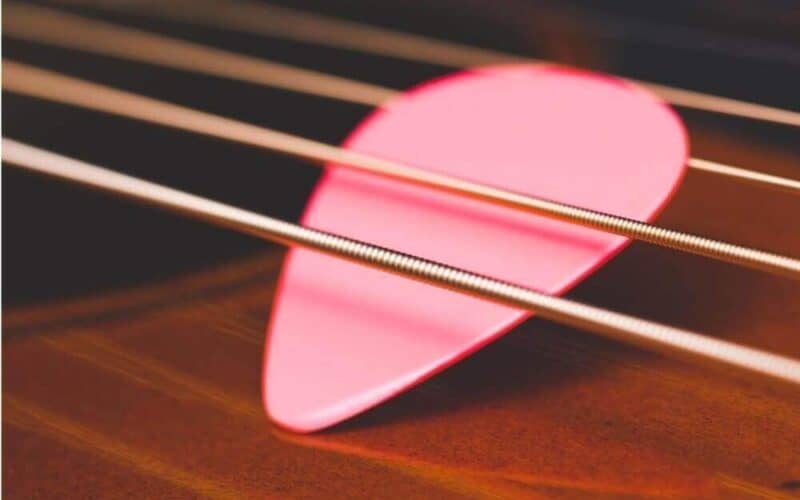As a guitar teacher with almost 20 years of experience, I often get asked, “What is the best guitar pick thickness for beginners?” As a guitar player myself, I remember struggling to find the right pick when I first started playing.
The small flat tool used to strum a guitar may seem insignificant, but the dimensions of a guitar pick significantly impact sound and playability.
When starting guitar, the variety of picks can feel overwhelming. I often see students purchase the first one they find, oblivious to how drastically picks can alter technique. The right pick improves control and aids development. An unfitted pick hinders skill growth.
In this article, I leverage my years of expertise to explore the various types of guitar picks, providing key considerations around size, shape and thickness to help you determine the ideal pick for your playing style and guitar type.
Plectrum Vs Pick: What Is A Plectrum?
Simply stated, a plectrum (the formal name for a guitar pick) is a small and thin object with a flat surface that’s used to strum stringed instruments like guitars, mandolins, and harpsichords.
You may also hear guitarists refer to “picks” as “plectrums.” While these terms can be used interchangeably, plectrum is considered more formal.
The word pick likely emerged from the practice of using bird quills, bones, or wood slivers to pluck instruments. Plectrum comes from the Greek word meaning “anything to strike with.”
These pieces can be made of various materials ranging from plastics to tortoise shells to ivory. Plectra comes in different dimensions, structures, and thicknesses and these all play roles in improving the overall tonal quality of the instrument.
With that said, a guitar pick is a type of plectrum that’s specifically designed for strumming guitars. But in most cases, both of these terms are used interchangeably.
Why Use A Guitar Pick?
One of the main queries that beginners always ask us is this: why use a pick? After all, a lot of professional musicians can be seen playing their guitars with no help from picks. And honestly, there’s nothing wrong with that.
But, I still recommend using a pick – especially if you’re a beginner. If you’re not convinced, here are some of the reasons why you need to use a pick:
- Picks help produce louder sounds. First of all, picks allow you to exert more effort into playing – and when you play harder, the sound that your guitar produces is usually louder. Unlike if you’re strumming with your fingers, strumming strings hard can be painful. Thus, it’s best to use a pick if you want your guitar to sound louder without any feeling or pain on the finger.
- Picks help you play faster. Similarly, using a plectrum to play will allow you to play quicker. You don’t have to worry about blisters in your fingers if you’re playing with a pick since the impact does not go directly to your fingers.
- Picks allow you to create more defined tones. And eventually, picks are known for producing fuller tones. Depending on the thickness of the pick, you can create the ideal tone you want your guitar to produce. We’ll discuss more on this shortly.
From all these, it’s easy to see why using a pick is better for beginners. Doing so will help you develop more authority over your wrists while you’re still in the early stages of your training.
Guitar Pick Dimensions And Measurements
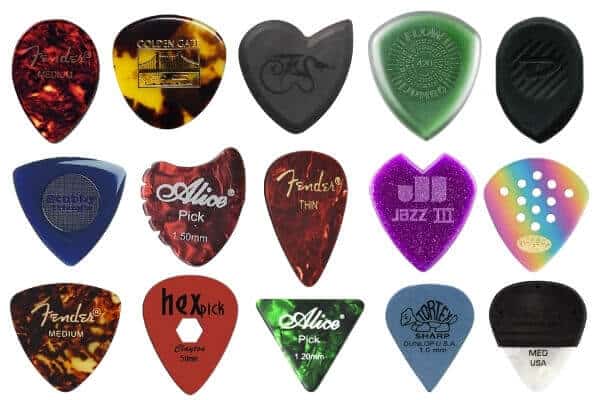
When selecting a guitar pick, understanding the various measurements and specifications is key to finding the best fit for your playing style and guitar type.
In this section, I will explore the critical dimensions of guitar picks including thickness, shape, size, texture and common materials, breaking down the meaning of numeric measurements and how variations impact tone and feel during play.
Guitar Pick Thickness
According to thickness, guitar picks are classified into five as stated below:
1. Extra Thin: These picks are those that are less than 0.45 mm thick. This makes them incredibly flexible, which allows them to generate lighter and more lively tones.
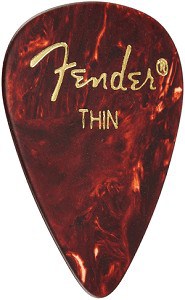
2. Thin or Light: Thin or light picks are those that fall between 0.45 to 0.69 mm thick. They are slightly stiffer than extra-thin picks, but they similarly make light tones.
The main difference is that thin picks have a little more bass and midrange compared to additional thin ones.
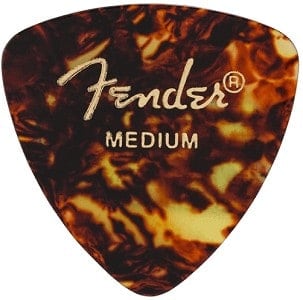
3. Medium: Medium guitar picks, on the other hand, are those ranging between 0.70 and 0.84 mm thick. Because of their stiffer build, you can exert more power when playing, and this allows you to create rhythm more accurately.
For this reason, medium picks are the top choice for rhythm guitarists.
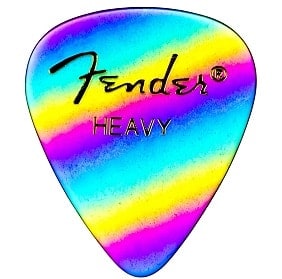
4. Thick or Heavy: Taking it up a notch are thick or heavy picks. These picks fall between 0.85 and 1.2 mm thick. Because of their stiffness, these picks are more pleasant and easier to play – even at a speedy pace to do fast alternate picking.
They are also known for producing loud sounds that have a lot of bass tones. For this reason, thick picks are the favorite choice of musicians with more aggressive playing styles.
5. Extra Thick or Extra Heavy: Finally, these types of picks are those that are thicker than 1.20 mm. Like the heavy ones, these are known for producing booming bass sounds even if played on an acoustic guitar.
Similarly, these extra heavy guitar picks are also pleasant and easy to play fast notes with.
Guitar Pick Thickness Chart
If what I discussed above seems to be too complicated, then here is a simplified guitar pick thickness chart for you to look into.
| Label | Thickness (in millimeters) | Thickness (in inches) |
| Extra Thin/Light (Ex Lite) | Less than 0.45 | Less than 0.018 |
| Thin or Light (T/L) | 0.45 to 0.69 | 0.018 to 0.027 |
| Medium (M) | 0.70 to 0.84 | 0.028 to 0.033 |
| Thick or Heavy (H) | 0.85 to 1.20 | 0.033 to 0.047 |
| Extra Thick/Heavy (XH) | More than 1.20 | More than 0.047 |
Guitar Pick Sizes
Now, we move on to guitar pick sizes. Pick sizes are generally classified into two: big and small picks. These options do not offer much tonal difference, but it all boils down to how comfortable the guitarist is while playing.
Big picks provide guitar players with an easier and more comfortable hold over the pick, and this allows them to strum the guitar strings with ease. What you have to take note of when you’re using a big pick is that it does not offer much finger dexterity. Thus, use this if you’re playing slower and more relaxed melodies.

On the other hand, smaller picks offer better finger dexterity. As such, it allows you to play notes with more accuracy. This is perfect if you’re playing songs with intricate musical details that you want to emphasize.
Guitar Pick Shapes
There are so many pick shapes available in the market today that it’s already hard to keep track of all of them. But even with the variety of structures out there, there is only one thing that you have to look out for: the tip of the pick.
The sharpness of the tip is the key factor of a pick shape cause this is the only thing that does contact with the strings to produce sound. Guitar picks with rounded shape tips initiate a softer sound, and this works better for more relaxed playing.
It is for this reason that an acoustic guitar pick often has rounded tips. Those who prefer an aggressive picking style and a stronger attack on the strings while playing can go for picks with more pointed or sharper tips.
These appointed tips help a lot with the accuracy of playing each note, playing arpeggios, or using a technique like string skipping while also offering added dexterity for your fingers. This makes it the weapon of choice for musicians who have to perform complicated solos or fast alternate picking.
Guitar Pick Texture
A pick’s texture impacts both grip and tone. Smooth surfaces tend to slip more easily from sweaty fingers during passionate shredding. Textured picks provide extra friction for better control.
However, they also add some grittiness to your sound. It’s a trade-off between playability and purity of tone. So if pristine notes are paramount, you may have to risk the occasional flubbed finger flip.
For most players though, the extra confidence of a textured grip wins out. Try both to see what clicks best. In time, your hands may adjust to either one as extensions of your musical soul.
Guitar Pick Materials
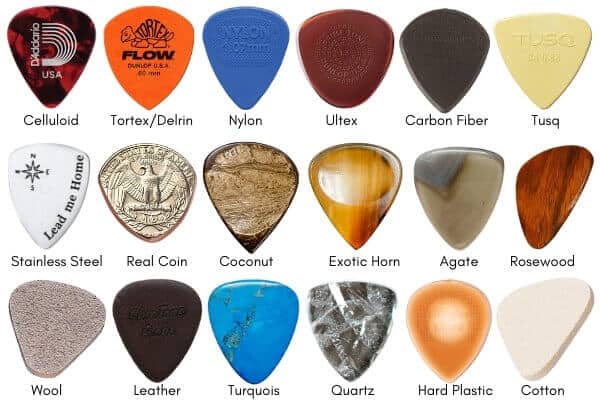
The guitar pick material helps you determine the quality of the notes you play. Nowadays, guitar picks are made from so many different materials that discussing them all would take too much of your time.
Here are some of the most popular materials used in making picks for your reference:
Cellulose:
Celluloid picks are made from cellulose, one type of wood-based bio-plastic. These are considered the most common picks today. Since cellulose is one of the most abundant materials around, this makes them sustainable.
As a result, these celluloid picks are affordable and easy to find.
Celluloid guitar picks have an oily or smooth texture, and this allows the guitar player to play with sufficient dexterity without sacrificing his accuracy.
Delrin:
Another common material is Delrin, which is a type of acetal homopolymer resin. These picks are hard and durable, and this allows them to produce that loud sound that everybody loves.
Despite its glossy texture, Delrin picks provide the user with a firm grip, so they don’t have to worry about losing control over the pick while in the middle of playing.
Delrin is also the known material used for the Tortex guitar pick, an alternative to tortoiseshell picks. Tortoiseshell picks used to be the holy grail of picks because of the rich tones that they can make.
However, since there has been a ban on using these shells, manufacturers have resorted to using Tortex instead.
Nylon:
Another widely popular material used for guitar picks is nylon. Nylon picks are known for being inexpensive and have become the favorite choice for beginners.
Because of its flexible material, a nylon pick helps improve the guitarist’s strumming technique. It also assists in creating warm tones, making them perfect for jazz and similar music.
Now, you already know the different materials used in producing picks. If you correlate this with our discussion on pick thickness, size, and shape, you can easily choose the perfect pick for you.
How To Choose A Guitar Pick
I’m often asked by students what guitar pick should I use. Now that you know the different guitar pick forms, sizes, and thicknesses, now I can proceed with choosing the perfect pick for you.
Based on everything I have previously discussed, you can already narrow down your choice of pick depending on your preferred tone, playing style, and how accurately you want to play the notes.
For acoustic guitars, thin or medium picks allow comfortable strumming while producing bright tones. Electric guitars typically pair better with medium or heavy picks for solid lead notes. Bass guitars may require thicker picks to match heavier gauge strings.
Next, test different materials. Celluloid and nylon offer flexibility for intricate plucking. Acetal and Ultem provide rigid durability to aggressively attack strings. Try out different textures too – some players prefer smooth surfaces while others like textured grips.
You’ll also want to experiment with different shapes. Standard picks offer versatile utility for both strumming and precision. Jazz styles enable effortless high-speed maneuvers. Larger grips cater to big hands. Figure out which angles and curves feel best as an extension of your fingers.
Without the right pick, your killer riffs could fall flat. So take the time to discover an optimal balance of firmness and flexibility tailored to your personal preferences.
Does The Pick Thickness Make A Difference?

From everything I have discussed, you can already see that the thickness of a guitar pick creates a difference in tone and even in playability. While it may not be obvious to the untrained ear, professionals and music enthusiasts can effortlessly spot the difference.
To recap, thinner picks produce lighter tones with less bass, while medium-size picks are stiffer than thinner picks to deliver a louder and brighter tone with higher bass. But heavier picks produce louder sounds with deep bass tones. Make sure to consider this before purchasing one.
Frequently Asked Questions
What size guitar pick should a beginner use?
The size of the guitar pick generally depends on what you plan to use the guitar for. If you’re planning to become a lead guitarist one day, I recommend using a small and thick pick with a pointed tip since this will help you play faster and more accurately.
But if you’re planning to play your guitar at a more relaxed pace with more focus on rhythm, then you can go for a big pick with medium thickness and a rounded tip. This allows you to play more comfortably while giving your fingers enough control over your guitar-playing.
What mm pick should I use for acoustic guitar?
The thin or light guitar picks (0.45mm to 0.69 mm) are great for delicate playing on acoustic guitars because they will give you more treble when sliding across the strings. But they provide less control than heavier picks because they flex and bend easily with every note played on an acoustic instrument.
Also, If you’re into strumming and looking for a softer tone or playing acoustic guitar as a background instrument, an extra thin or extra light pick under 0.45mm thickness would be a better option
Our Top Guitar Pick Recommendations
Are you ready to elevate your guitar playing to new heights? The journey starts with the right pick in your hands.
I’ve curated a list of the best guitar picks tailored for various playing styles and conditions. Let’s dive into our top recommendations:
For acoustic guitar playing, I recommend the Fender 351 Celluloid Medium. This pick provides a smooth, warm, rounded tone perfect for softer genres. Its 1.0mm thickness strikes an ideal balance of flexibility and control.
For electric guitar, I suggest the Jim Dunlop Tortex Flow. With a slick surface and tapered tip, this pick offers effortless speed across the strings while retaining sharp attack ideal for articulate leads.
Bass players should try the D’Addario Planet Waves Black Ice. Its soft-touch texture prevents slippage during rapid-fire playing while its thickness brightens bass tone with enhanced pick attack.
For strumming, the Clayton Ultem Standard is an excellent choice. With beveled shoulders and a smooth surface, strumming is fluid and comfortable during longer playing sessions.
For metal guitar playing, I recommend Ernie Ball Prodigy Picks. With beveled edges and textured grip, these picks allow aggressive playing while minimizing slippage. Their thickness also produces a bright tone perfect for the metal genre.
For fast lead playing, Dragon’s Heart GT picks excel. With its smooth finish and tapered shape, this pick allows guitarists to effortlessly transition between strings when playing lightning-quick solos and riffs.
For jazz-style guitar playing, Dunlop Jazz III is an optimal choice. The smaller size allows precision while the stiffness articulates complex chording cleanly.
Finally, for beginners still developing technique, Dunlop Nylon Standard picks provide a flexible, forgiving feel that builds confidence during initial learning stages.
Final Words
To find a pick of choice, beginner guitarists can try every pick to determine what works for them regarding their preferred tone, music style, and feel comfortable in hand. There’s nothing incorrect about experimenting with pick thicknesses and dimensions to get a good plectrum.
All guitar players have their personal preference to choose a specific type of pick, and that can change many times as they become more experienced.
So start testing different picks until you find the best-suited pick for yourself.
About the Author
Gustavo is a music teacher and classical guitar player from Brazil, currently residing in Dublin, Ireland. He holds a graduate degree in Classical Guitar Performance from the Federal University of Pelotas. In 2020, Gustavo successfully completed a Master's degree in Sound Engineering from the Academy of Sound in Ireland.

